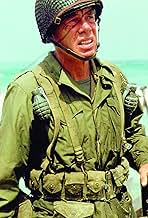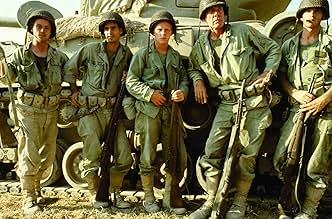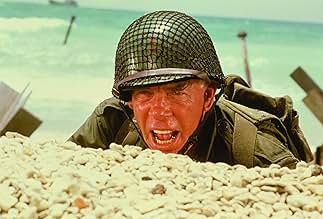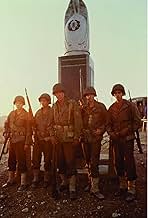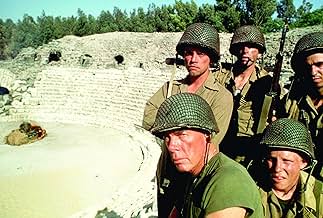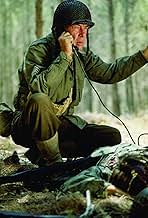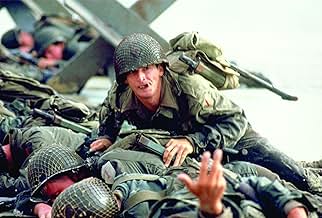VALUTAZIONE IMDb
7,1/10
22.330
LA TUA VALUTAZIONE
Un sergente veterano e i quattro membri principali della sua unità di fanteria cercano di sopravvivere alla seconda guerra mondiale mentre si spostano di battaglia in battaglia attraverso l'... Leggi tuttoUn sergente veterano e i quattro membri principali della sua unità di fanteria cercano di sopravvivere alla seconda guerra mondiale mentre si spostano di battaglia in battaglia attraverso l'Europa.Un sergente veterano e i quattro membri principali della sua unità di fanteria cercano di sopravvivere alla seconda guerra mondiale mentre si spostano di battaglia in battaglia attraverso l'Europa.
- Regia
- Sceneggiatura
- Star
- Premi
- 2 vittorie e 2 candidature totali
Stéphane Audran
- Underground Walloon Fighter at Asylum
- (as Stephane Audran)
Recensioni in evidenza
A lot of people hate The Big Red One. They call it farcical, uneven, clichéd. They find it farcical, I believe, because the film revels in the absurdity of war rather than gloss over it. They would rather watch a film, like Saving Private Ryan, which ignores absurdity in favor of violence. These people find it uneven because the "important scenes" (like the D-Day and North African invasion) take only a minute or two to conclude, while other scenes, less typical of a war movie, spread out before us. They call it clichéd because the movie is unsubtle in its treatment of character development and plot.
I cannot agree with these beliefs. The Big Red One is not only one of the greatest WWII films, it is also one of the greatest war movies.
Sam Fuller's film, which was butchered by the studio, is the picaresque tale of 5 members of the First Infantry, known, because of their shoulder patch, as the Big Red One. The film moves from one story to the next without spending too much time on any particular tale.
The individual vignettes, as they must, vary in quality, but on the whole are excellent. The Big Red One stirs within you a desire to run right out and tell your friends about this amazing scene or that.
There's the soldier who loses his testicle, the birthing scene in the belly of a tank, Lee Marvin, in Middle Eastern garb, traipsing across a beach, soldiers dug into holes over which a Panzer tank division travels, the entire Mad House segment... The list goes on.
Some people dislike the absurdest nature of several of this film's stories, but, for me, those surreal touches make this film great.
Without them (and there are a lot), you would be left with a very normal and very boring film. Using bandoleers as stirrups is genius, as is the woman faking crazy as she whirls through a monastery, slicing German throats.
The performances are solid, for this type of film, but if you are looking for subtlety, go elsewhere. Each character is drawn in broad strokes; you never learn too much about them, but you learn enough to understand who they are and why. Lee Marvin, as usual, is amazing. He is one of the great, gruff actors of our time, bringing a special, intangible quality to every film in which I've seen him. He makes every movie he's in better just by showing up. There are too few actors about whom you can say that.
Like the acting, the direction is masculine, but, for a war movie, that's a compliment. In some ways, Fuller's direction here and in his other films reminds me of Hemmingway's writing - terse and effective. Both men believe in an economy of shots or words, depending on their medium, but, through that economy, they attain a muscular sort of poetry akin to the beauty of a horse's rippling muscles as it races on a plain. Fuller's direction here, though not his best when compared to Underworld USA or Shock Corridor, is still better than most, especially considering that this was his first film in several years.
All in all, I find the Big Red One to be an exemplary war movie, even in its emasculated format (I cannot wait to see the restored, 140 minute print, which should improve upon scenes that feel to brief in this version). It's certainly no Apocalypse Now, but it puts to shame most World War II epics before or since.
I cannot agree with these beliefs. The Big Red One is not only one of the greatest WWII films, it is also one of the greatest war movies.
Sam Fuller's film, which was butchered by the studio, is the picaresque tale of 5 members of the First Infantry, known, because of their shoulder patch, as the Big Red One. The film moves from one story to the next without spending too much time on any particular tale.
The individual vignettes, as they must, vary in quality, but on the whole are excellent. The Big Red One stirs within you a desire to run right out and tell your friends about this amazing scene or that.
There's the soldier who loses his testicle, the birthing scene in the belly of a tank, Lee Marvin, in Middle Eastern garb, traipsing across a beach, soldiers dug into holes over which a Panzer tank division travels, the entire Mad House segment... The list goes on.
Some people dislike the absurdest nature of several of this film's stories, but, for me, those surreal touches make this film great.
Without them (and there are a lot), you would be left with a very normal and very boring film. Using bandoleers as stirrups is genius, as is the woman faking crazy as she whirls through a monastery, slicing German throats.
The performances are solid, for this type of film, but if you are looking for subtlety, go elsewhere. Each character is drawn in broad strokes; you never learn too much about them, but you learn enough to understand who they are and why. Lee Marvin, as usual, is amazing. He is one of the great, gruff actors of our time, bringing a special, intangible quality to every film in which I've seen him. He makes every movie he's in better just by showing up. There are too few actors about whom you can say that.
Like the acting, the direction is masculine, but, for a war movie, that's a compliment. In some ways, Fuller's direction here and in his other films reminds me of Hemmingway's writing - terse and effective. Both men believe in an economy of shots or words, depending on their medium, but, through that economy, they attain a muscular sort of poetry akin to the beauty of a horse's rippling muscles as it races on a plain. Fuller's direction here, though not his best when compared to Underworld USA or Shock Corridor, is still better than most, especially considering that this was his first film in several years.
All in all, I find the Big Red One to be an exemplary war movie, even in its emasculated format (I cannot wait to see the restored, 140 minute print, which should improve upon scenes that feel to brief in this version). It's certainly no Apocalypse Now, but it puts to shame most World War II epics before or since.
This film is really about the experiences that Sam Fuller had during WWII. It is a bit dated, and the low budget really shows, but SF clearly did the best with what he had, and it stands as a great monument on war from a director who was really there.
All of the characters are very likeable, and well acted by Lee Marvin, Mark Hamill, Robert Carradine, and company. The movie is fiction but influenced by real events. Many of the scenes, especially one involving a group of older sicilian women who cook a big meal for the squad, ring very true, since a fiction writer would obviously try and spice them up--the film is very honest, and it is good that Fuller left this story for us. I also like how it ends on a positive, optimistic note.
"The real glory of war is surviving."
All of the characters are very likeable, and well acted by Lee Marvin, Mark Hamill, Robert Carradine, and company. The movie is fiction but influenced by real events. Many of the scenes, especially one involving a group of older sicilian women who cook a big meal for the squad, ring very true, since a fiction writer would obviously try and spice them up--the film is very honest, and it is good that Fuller left this story for us. I also like how it ends on a positive, optimistic note.
"The real glory of war is surviving."
I thought I had seen all the WW2 movies out there but I guess this one was off the radar. There are for sure now better movies to be seen but this is worth the watch.
It is basically a movie that follows one platoon as they go through the war, and how each individual soldier wrestles with various demons so to speak. There is enough action to keep things moving.
Would recommend to anyone who likes, war movies, actions movies or seeing Luke Skywalker as a young soldier.
It is basically a movie that follows one platoon as they go through the war, and how each individual soldier wrestles with various demons so to speak. There is enough action to keep things moving.
Would recommend to anyone who likes, war movies, actions movies or seeing Luke Skywalker as a young soldier.
"The Big Red One" is an episodic war movie from maverick American filmmaker Samuel Fuller. Having only seen "Shock Corridor" from the director's oeuvre, I didn't know what to expect from him this time around. It becomes obvious pretty quickly that Fuller was never going to be a mainstream filmmaker. There's something about his style that's really off-putting. You empathise with the camera, not the actors. It's like they're at odds with each other.
This is not a bad thing, as you can tell from the enthusiastic reception Fuller's movies have gotten here on IMDB. But "The Big Red One" is also drastically cut down from the original print Fuller had, and I wonder if that's why it feels so disjointed.
Of course, it is supposed to be episodic, but I don't know. I didn't really get into it.
This is not a bad thing, as you can tell from the enthusiastic reception Fuller's movies have gotten here on IMDB. But "The Big Red One" is also drastically cut down from the original print Fuller had, and I wonder if that's why it feels so disjointed.
Of course, it is supposed to be episodic, but I don't know. I didn't really get into it.
This review is on the "reconstructed" DVD, a version that came out several years ago, adding 49 minutes to the original 1980 movie. (The film runs 162 minutes, not 158 as stated on the IMDb title page.)
The "old" version was very good, and this newer version makes the film even better. Either way, you have a solid war movie.
For men - and that's who will primarily watch this movie because it's a guy's flick with no romance and no women leads - this keeps the action coming, but without overdoing it. You can different kinds of action scenes, too, not just people shooting at one another.
I also appreciated the photography. It's a good visual movie. The added footage looked sharper and clearer than the previously shown, but either way it was nicely filmed and directed. Of course, the director is the famous Sam Fuller, who did a number of tough film noirs, among other things.
Speaking of tough, the person who makes this movie a notch above average is Lee Marvin. He is just excellent as the tough-on-the-outside-but-soft-hearted underneath commanding officer, known only as "The Sergeant." With his deep voice and weathered face, Marvin makes for an effective leader of tough guys. The language was much milder in here than you find in more modern films, although it can be crude in a few spots. There are no f-words and about seven usages of the Lord's name in vain. However, there are a number of sexual references, some crude but, hey, that's "guy talk." All the young soldiers were good, too. It was especially interesting to see baby-faced Star Wars' star, Mark Hamill, playing one of the soldiers in the unit called "The Big Red One."
The story with narration by one of the soldiers, tells of Marvin and his handful of men who travel and do battle from North Africa to Sicily, then Italy, the beaches of Normandy on D- Day and into Germany in addition to a few other memorable stops such as "an insane asylum."
It's long, but I never found it boring and the men never stay too long in one spot.
The "old" version was very good, and this newer version makes the film even better. Either way, you have a solid war movie.
For men - and that's who will primarily watch this movie because it's a guy's flick with no romance and no women leads - this keeps the action coming, but without overdoing it. You can different kinds of action scenes, too, not just people shooting at one another.
I also appreciated the photography. It's a good visual movie. The added footage looked sharper and clearer than the previously shown, but either way it was nicely filmed and directed. Of course, the director is the famous Sam Fuller, who did a number of tough film noirs, among other things.
Speaking of tough, the person who makes this movie a notch above average is Lee Marvin. He is just excellent as the tough-on-the-outside-but-soft-hearted underneath commanding officer, known only as "The Sergeant." With his deep voice and weathered face, Marvin makes for an effective leader of tough guys. The language was much milder in here than you find in more modern films, although it can be crude in a few spots. There are no f-words and about seven usages of the Lord's name in vain. However, there are a number of sexual references, some crude but, hey, that's "guy talk." All the young soldiers were good, too. It was especially interesting to see baby-faced Star Wars' star, Mark Hamill, playing one of the soldiers in the unit called "The Big Red One."
The story with narration by one of the soldiers, tells of Marvin and his handful of men who travel and do battle from North Africa to Sicily, then Italy, the beaches of Normandy on D- Day and into Germany in addition to a few other memorable stops such as "an insane asylum."
It's long, but I never found it boring and the men never stay too long in one spot.
Lo sapevi?
- QuizThe bulk of the picture was shot in Israel, and director Samuel Fuller remarked that it was unsettling after a scene was shot when the German soldiers and SS troops would take off their helmets and Fuller would see them wearing yarmulkes; also, between takes they would be sitting around the set in full Nazi uniform speaking Hebrew or reading the Torah.
- BlooperDuring the WW1 scene between the Sergeant and the officer in the dug-out, the Sergeant learns that the armistice had been signed 4 hours previously at 1100hrs, November 11, 1918. While talking with the officer, the sergeant is cutting a piece of red cloth in the shape of a number '1' which he says he will submit as a proposed insignia for the division. However the shoulder sleeve insignia for the 1st Division consisting of a red number "1" was already approved on 31 Oct 1918.
- Citazioni
Johnson: [concerning a woman in labor] How do you say "push" in French?
The Sergeant: Poussez.
Johnson: [to woman] Pussy! Pussy! Pussy!
- Versioni alternativeIn 2004, film critic Richard Schickel restored this film to a new director's cut length of approximately 160 minutes. Using Samuel Fuller's production notes and the full-length, unexpurgated script, Schickel restored the footage that was forced to be cut by the studio upon its original 1980 release (which runs 116 minutes). The restored version's DVD release date is 3 May 2005. This longer, epic-length version is closer to Fuller's original vision for the film.
- ConnessioniFeatured in A tout coeur: Episodio datato 7 maggio 1984 (1984)
- Colonne sonoreHorst-Wessel-Lied
Written by Horst Wessel
I più visti
Accedi per valutare e creare un elenco di titoli salvati per ottenere consigli personalizzati
Dettagli
- Data di uscita
- Paese di origine
- Lingue
- Celebre anche come
- Más allá de la gloria
- Luoghi delle riprese
- Aziende produttrici
- Vedi altri crediti dell’azienda su IMDbPro
Botteghino
- Budget
- 4.500.000 USD (previsto)
- Lordo Stati Uniti e Canada
- 7.206.220 USD
- Lordo in tutto il mondo
- 7.206.823 USD
- Tempo di esecuzione1 ora 53 minuti
- Colore
- Mix di suoni
- Dolby Stereo(original release)
- Proporzioni
- 1.85 : 1
Contribuisci a questa pagina
Suggerisci una modifica o aggiungi i contenuti mancanti


